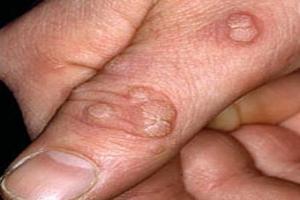WARTS-CAUSES, SYMPTOMS AND MANAGMENT ACCORDING TO AYURVEDA AND MODERN SCIENCE

Warts are growths on the skin caused due to infection with human papilloma virus (HPV).Most HPV types cause relatively less harmful conditions like common warts, but some can cause cause serious disease such as cancer of the cervix.
In Ayurveda, warts can be compared with Charmakeela. The pathogenesis of this disease due to vitiation of Vata along with Kapha over the skin causes the development of hard nail structures called Charmakeela.
The incidence of warts is highest in children and young adults.
In Ayurveda, the features are described on the basis of domination of the Doshas.
1. In Vata dominated Charmakeela- patient feels pricking type of pain,
2. in Kapha domination it appears like nodule without changing the color of the skin,
3. in Pitta dominated Charmakeela due to vitiation of Rakta (blood), it appears blackish in color, dry, oily and hard in nature.
According to modern science, different types of warts have been identified, which are differing in shape and site, as well as the type of human papillomavirus involved. These include:-
1.Common wart (verruca vulgaris): A raised wart with roughened surface, most common on hands and knees
2. 2. Flat wart (verruca plana): A small, smooth flattened wart, tan or flesh colored, which can occur in large numbers; most common on the face, neck, hands, wrists and knees.
3.Filiform or digitate wart: A thread or finger-like wart, most common on the face, especially near the eyelids and lips.
4. Plantar wart (verruca, verruca pedis): A hard sometimes painful lump, often with multiple black specks in the center; usually only found on pressure points on the soles of the feet.
5. Mosaic wart: A group of tightly clustered plantar-type warts, commonly on the hands or soles of the feet.
6. Genital wart (venereal wart, condyloma acuminatum, verruca acuminata): Wart affecting the genital areas.
The management of warts-
The management of warts depends on the age of the patient, the site of infection, the size, number and types of warts involved, the patient's immunological status, treatment availability and cost, and the patient's desire for therapy and ability to adhere to the treatment regimen. For children, it is desirous to have an effective and painless treatment that shows rapid results.
According to allopathy, the management consists mainly in destroying the warts by different methods like chemically, electrically or surgically and these can be achieved by cryosurgery, keratolytic ointments, plasters and solutions, curettage, electrodesiccation, and destructive acids.
In Ayurveda, it was described that the attainment of total management by using the internal drugs, external applications and Kshrakarma and Agnikarma.
I.Lekhana karma (scraping procedure)-Stalks of the betel leaf, mixture of lime + copper sulfate in equal quantity.
II.Application of the Kshara Jala (alkali lotion)Paste of the Changeri leaves-rubbing
III.Thermal cauterization (Agnikarma) – After infiltrating the L.A at base, the warts can be excised by red hot Shalaka (pointed metallic rod) or electro cautery.
IV.Ligation of the horse hair or Kshara sutra – Horse hair or Kshara sutra should be tied after applying around the base of wart.
ï¬Internal medications like Arogyavardhini, Manjishthadi kwatha, Vatari gugglu (internal medicines are having limited role and may help in preventing recurrence after excision of the warts).
                                                                                Â